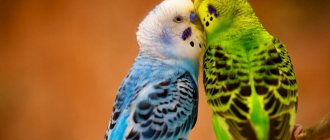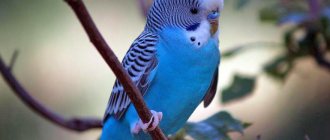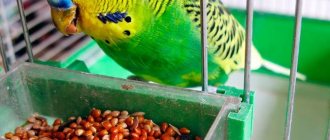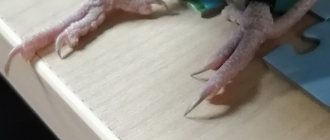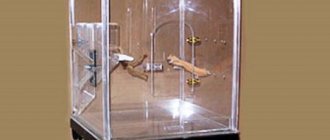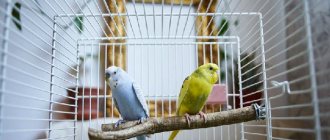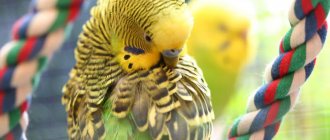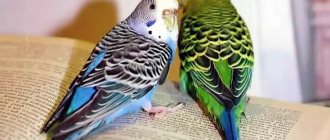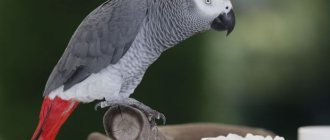All pets, including birds, love to splash around in warm water. But in order for bathing to be beneficial and not harm your feathered friend, you need to know how to properly bathe a budgie. This is not difficult to do at home.
Is it possible and necessary to bathe budgies?
Washing is not the most essential element of caring for and maintaining budgies. Each bird owner must decide for himself whether to bathe a budgie or not, focusing on the need for such bathing and the desire of the pet. There are enough advantages in water procedures:
- During bathing, all foreign chemicals are washed off , especially if the pet was stained with paint or glue the day before.
- Water treatments help moisturize the feathers and skin of a budgerigar, which is important in the dry air of city apartments.
- In the summer, water procedures are the best prevention of heat stroke in birds.
- Many birds love to swim !
Another question is that in cases where a pet flatly refuses to take water procedures - it gets restless, disheveled and shows dissatisfaction in all appearances, you should refuse bathing and consider other types of hygiene maintenance. Forced washing causes severe stress in the parrot, which negatively affects its general condition, mood and interferes with good communication with other family members. Once you break your pet's trust, you can spend many years trying to get him back.
How many times can you bathe and how often do you wash your budgie?
The frequency with which it is recommended to bathe budgies depends on several factors:
- Seasons. In winter, experts do not recommend getting carried away and washing your pet more than once a month. In summer, it is allowed to increase the number of baths to three or four times a month. Although, if there are hot summer days outside, when it’s stuffy and you want to freshen up, at this time of year you can bathe the bird every other day. The same applies to winter - if the house is warm and the feathered friend wants to swim (or needs it), then water procedures are allowed once a week.
- Bird moods. If your feathered friend is anxious, you should not offer him a bath.
- Physical condition of the parrot. All recommended standards for water procedures apply only to healthy birds. If the pet is sick, then water procedures must be canceled until recovery.
You should not bathe in the first two weeks after buying a bird - during this adaptation period the stress will be too strong, which will definitely affect your health. It is best to accustom him to water procedures after the parrot has gotten used to the owner, has settled into the cage and calmly allows himself to be picked up.
Important! To understand whether your budgerigar needs to be bathed, you should take a close look at your pet: the first signs that it’s time to wash are an active interest in water – playing with a drinking bowl, attempts to splash water on itself, ruffling of feathers at this moment.
What can you replace water with?
If your house is very cold, you are in the process of getting used to water and your parrot is simply afraid of it, then you should buy mineral sand. It will be a good alternative; in the future you will be able to combine sand and water treatments.
It is worth buying sand from a trusted place so that you can be sure of its purity. Sand should be placed in a container or a special bathing suit and toys should be placed in it. Usually the birds quickly become interested in what it is and begin to bathe in the sand.
How to prepare for bathing budgies at home?
The first and most important condition for washing a parrot is the bird’s good mood and a trusting relationship with the owner. When swimming indoors, any shallow and wide container of water will do.
You should pay attention to the following points when organizing a bath for your budgie:
- The apartment must be kept warm - the temperature in the room must be at least twenty degrees Celsius, the windows must be closed, and if there is an air conditioner, it must be turned off. This will prevent the parrot from catching a cold after the water procedure and avoid drafts. It is better not to bathe your budgie when the temperature in the apartment is below the required level.
- to pour warm drinking water into the bathing suit for budgies , in case the pet decides to swallow it.
- The optimal water level is one that does not exceed 1.5-2 centimeters .
- It is not recommended to swim in brightly lit areas. Twilight allows the parrots to relax and take the procedure more calmly.
If the feathers are heavily soiled, you should also prepare a cleaning agent - it is better to choose specialized shampoos for birds. As a last resort, you can use fragrance-free baby shampoo.
Important! The use of detergent when bathing budgies should be extremely careful and should be used only in cases of really strong contamination (for example, paint or fly glue) that the bird cannot clean on its own. The minimum concentration should be used; if the product requires rinsing, it is necessary to rinse the shampoo off the pet as much as possible! Remember that any foreign chemicals can negatively affect the health of your feathered pet!
chamomile infusion has worked well , but you can also use clean water.
Bathing for a parrot: how to train it?
Special bath for birds.
A parrot's preferences for bathing can only be determined by trying all the options. For the owner, the easiest way is a specialized bath for washing parrots, colloquially called a bathing suit. However, some birds are afraid of closed spaces and cannot be lured there. How to accustom a parrot to a bath?
First of all, play on the curiosity of your feathered friend: if the butt is interested in something, he should definitely explore it. The same bathing suit equipped with a mirror can become such an item. Intrigued by the sight of its own reflection, the wavy will risk climbing into the bath.
The bird's interest will be attracted by its toy placed in the container or its favorite treat, a shiny ball.
Accustoming to a bath can be done gradually: first, a little grain mixture and sand are placed there, and when the parrot gets used to it and climbs into the bath without fear, a little water is poured in.
You shouldn’t elevate bathing your wavy pet to the level of a problem, much less how to get him to do it. Coercion has never benefited anyone. The stress suffered will lead to persistent hydrophobia and, most importantly, loss of trust in the owner. The bird itself should want to splash in the water, so there is no need to rush things. It is better to try to find a way that is acceptable for both of you and enjoyable for your pet - through play, encouraging curiosity.
What methods allow you to effectively bathe budgies at home?
There are many ways to wash budgies. Let's look at the main ones.
How to wash budgies with a spray bottle?
I think this is the easiest way. However, before you use it and bathe your budgie in this way, you need to know some rules:
- The spray bottle should contain warm water - about 25 degrees Celsius.
- You should not use a spray bottle if the parrot is shy - this will only worsen the fear of your offer to go for a swim.
- To bathe with a spray bottle, you need to remove the feeder from the cage , especially if there is still food in it.
- It is recommended to spray water at a distance of 30 cm , under no circumstances doing it sharply .
- The procedure time is about 10-15 minutes , but if the bird shows pleasure, it can be longer.
- After washing, you need to let the parrot dry and the cage to dry.
How to bathe a budgie using a bath?
If you have a bathing suit, you can bathe your parrot in it. The main task of the owner in this case is to interest the pet, to attract its attention to bathing, since the bird will independently spray water on itself. There are many tricks in this matter - some put a mirror at the bottom of the bath, or throw waterproof toys or treats into the water.
Important! When using a bathing suit, budgies splash drops of liquid far around them. Therefore, if it is installed in a cage, you need to protect the space around it, otherwise, place it where splashes can be easily removed.
In some parrot cages, the bath is permanently installed and cannot be removed. In this case, you need to ensure that there is always clean water .
Such cages are an ideal option for unobtrusively accustoming a budgerigar to bathing, so that he, without knowing it, gradually gets used to water procedures. But there are pitfalls here too - if the font is located on an elevated surface, then you cannot leave your budgerigar unattended while swimming. Wet plumage makes birds less agile, and they can easily damage themselves if they fall from a height.
After washing, it is necessary to replace the water with clean water so that the bird does not drink dirty liquid. In addition, after taking such baths, you need to dry your pet with a towel . Please note that hair dryers should not be used when drying parrots - they greatly dry out the skin and feathers, which leads to deterioration of plumage, and sometimes its loss. If your pet is very wet, it is better to place it under a regular lamp - its warmth will successfully dry it and no harm will be caused to its health.
And I'm afraid of water!
In principle, accustoming a feathered pet to water is not difficult. First, introduce the bird to a bath filled with water. Sit next to him, dip your fingers in the water and slowly move them in one direction or another. The parrot will closely monitor your actions. After some time, take water into your palm and carefully pour it over the back of the bird. If this does not throw her into panic, the desired goal will soon be achieved.
The simplest and most effective way is to place a small container (this could be a deep plate made from a toy dish) with water in the wavy cage. We repeat: parrots are very curious, and your pet will definitely be interested in a new object. At first, he will look closely and sniff, then he will dip his beak, try to climb in with his paws, and after some time he will eventually bathe entirely.
The spray bottle as a method of bathing has already been mentioned above. But this item will also help rid your feathered pet of his fear of water: just spray the “water panty” through a spray bottle a couple of times a day.
How else can you wash a budgie at home?
Using Wet Grass
This is one of the variations of washing in a bathing suit, but closer to how parrots bathe in their natural habitat. At the bottom of the bath (you can do without it) lettuce leaves are placed, which he can peck, or other grass so that he can rub himself. A minimal amount of water is poured, the main thing is wet leaves . Bathing occurs when the parrot begins to rub on the grass or play with it - this moisturizes the feather cover and cleans it. Wild parrots often clean their feathers on dew on plants, so this process is as natural as possible.
The main problems that arise when bathing budgies
The problems that most often arise when washing budgies are the following:
- It is necessary to carefully protect the bird from colds . Since feathered friends are very sensitive to drafts, they can easily catch a cold even in the summer. Especially if the cage is near an open window. At the first signs of a cold, you need to contact a veterinarian who will prescribe adequate treatment.
- Water or detergent getting into the bird's nostrils. In this case, the pet must be carefully turned upside down and held in this position, but no longer than 10 seconds.
- Some budgies, after bathing, begin to actively scratch their feathers , which is mistaken by bird owners for a disease. But there is no need to worry - this is a natural reaction of birds, this is how they bring their beauty to perfection.
Trust between the owner and the bird, patience and perseverance will help to introduce the pet to water procedures and make them fun for both the pet and his friend - the owner!
Let's go swimming. What will you need?
You need to prepare for parrot water procedures. First, you should decide what or with what you can bathe the bird. There are several options:
- You can use a plate as a bathroom. a specialized bath for birds, the so-called bathing suit,
- shallow plate or saucer,
- another convenient container,
- spray,
- table lamp (if necessary).
After bathing, there is no need to specifically dry the bird either with a towel or with a hairdryer - the latter is simply deadly for the parrot. If he gets very wet and you are afraid that he will catch a cold, you need to place a table lamp above the cage, and shade the second part of the home with something. The bird, having dried out and warmed up, will find some shade on its own to get rid of overheating.
Why does the wavy bite?
